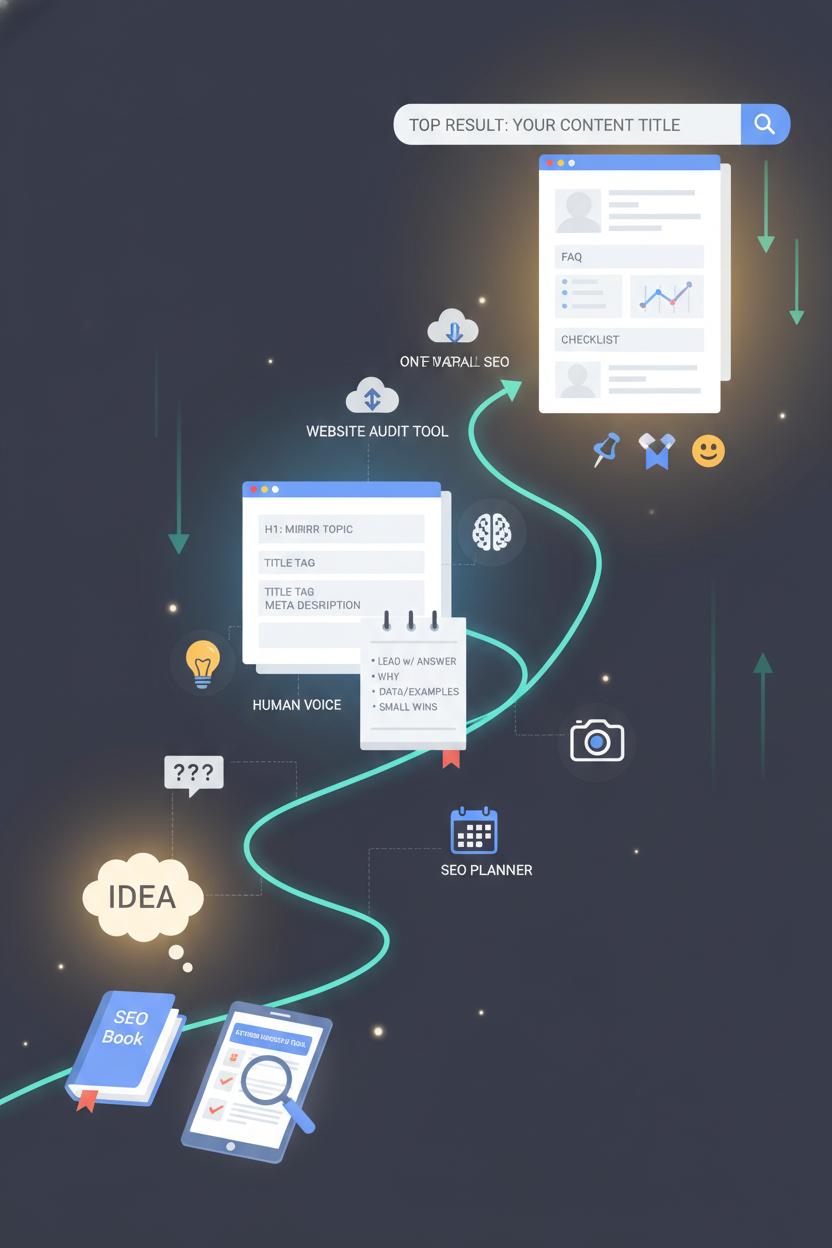Ready to climb the SERPs? This SEO checklist bundles proven seo tips and step-by-step search engine optimization to boost your google ranking fast. From smart keyword research and on-page seo tweaks to technical wins, you’ll learn what to fix, track, and scale. Grab your SEO planner, favorite keyword research tool, and a website audit tool to follow along. Want deeper dives? Keep an SEO book or content marketing book handy. Pin this guide and start optimizing today—the clicks, traffic, and conversions are closer than you think.
Define Your Goals and Baselines for search engine optimization and google ranking

Before you dive into tweaks and tactics, pause to define what success looks like for you—think of it as the vision board for your search engine optimization. Are you chasing a higher google ranking for your money pages, more qualified organic traffic, or a lift in newsletter sign-ups from blog posts? Choose one to three outcomes that truly matter for your business and make them specific and time-bound. For example: increase organic sessions by 30% in 90 days, earn top-3 positions for five target queries, or grow organic-assisted conversions by 20%. One of my favorite seo tips is to tie each goal to a metric you can measure and a decision you’ll make based on that metric, so progress actually guides your next move rather than just being a number on a dashboard.
Now establish your baselines—the cozy “before” picture you’ll compare against later. Open Search Console and note average position, impressions, click-through rate, and the queries already bringing you traffic. In Analytics, capture current organic sessions, top landing pages, and conversion rate from organic. Snapshot technical health too: Core Web Vitals, crawl errors, and index coverage. For on-page seo, review a handful of important URLs for title tags, meta descriptions, headers, internal links, and image alt text. A website audit tool can make this feel less overwhelming by bundling checks into one scan, and a reliable keyword research tool will help you size demand and competition for the phrases you care about most.
Round it out by mapping your keyword research to intent-led themes—what people want to do when they search—and assign a primary keyword to each priority page. Track everything in a simple sheet or, if you love stationery, an SEO planner that keeps goals, checklists, and content ideas in one pretty place. If you’re brushing up on strategy, an SEO book or content marketing book can offer frameworks for prioritizing what to publish next. Revisit your numbers at 30-, 60-, and 90-day marks so you can celebrate small wins, adjust what isn’t moving, and keep your plan feeling fresh. Clear goals plus honest baselines turn your optimization into a calm, creative process—one measured step closer to the rankings you’ve been pinning.
Choose a keyword research tool and Build Your Topic List

Start by brewing something cozy and cracking open your favorite keyword research tool—the one that makes you feel equal parts geeky and glamorous. Jot down seed topics your audience already loves, then explore variations that reveal intent: how-to phrases for helpers, comparisons for shoppers, and quick fixes for urgent problems. This is the heart of search engine optimization—matching real questions with satisfying answers—and it’s how your posts climb toward a better google ranking without feeling like a hard sell. If you’re a page-turner, keep an SEO book or a content marketing book on your desk for inspiration; sometimes a single chapter can spark a month’s worth of ideas. Bonus points if you flip through a brand-new SEO planner while you brainstorm—color-coded categories make everything feel plan-worthy and possible.
As your ideas grow, validate them with data. Look for long-tail keyword research opportunities with steady volume and low to medium difficulty; note seasonality; and check the search results to confirm intent. Peek at “People Also Ask” to harvest questions you can answer in sections or spin off as their own posts. If you’re auditing competitors, a lightweight website audit tool can reveal gaps your content can fill. Then cluster your list into themes—one pillar page with several related posts—so your internal links feel natural and your on-page seo is a breeze. Think titles that promise a transformation, meta descriptions that whisper benefits, and headers that walk readers step by step. Sprinkle in practical seo tips as you go, like including FAQs or adding a quick checklist for skimmers.
Finally, give your list a home. A simple spreadsheet or your trusty SEO planner can track target keywords, search intent, supporting posts, and publish dates. Treat your topics like a garden: revisit monthly, prune duplicates, and plant fresh ideas that show up in your keyword research as trends shift. Keep a column for updates so you can refresh older content when new data appears. The goal is a living library—organized, on-brand, and endlessly helpful—that nudges every post closer to the results you want and the readers who need you.
Create Rank-Worthy Content: seo tips From a Great SEO book or content marketing book

When you’re ready to create content that actually climbs in google ranking, think like a helpful host who anticipates every question a guest might ask. Crack open your favorite SEO book or content marketing book and you’ll hear the same gentle nudge: start with the searcher. Do a round of keyword research to map real intent—what they want to know right now and what they’ll need next. A simple keyword research tool can help you find the phrases, synonyms, and questions that make your piece feel complete rather than stuffed. Then outline with care: lead with the answer, layer in the why, and finish with the how-to. Search engine optimization rewards pages that feel satisfying, so weave in data, examples, and small wins your reader can try today.
Now, dress it beautifully with on-page seo that reads like a curated gallery: a clear H1 that mirrors the topic, a title tag and meta description that promise a benefit, subheads that guide the eye, and a short, human-friendly URL. Add internal links to related pieces so readers can keep exploring, and sprinkle in credible external sources to ground your advice. Use original images or screenshots where you can, write descriptive alt text, and keep paragraphs breathable and inviting. This is where craft meets clarity—search engine optimization loves structure, but humans crave voice, so let yours be warm, specific, and generous.
Finally, make it a habit, not a one-off. Use an SEO planner to map updates, seasonal refreshes, and new angles, and run a quick pass with a website audit tool to spot thin sections, broken links, or cannibalized topics. Track what resonates (time on page, clicks, saves), and iterate—those tiny improvements compound. Favorite seo tips from any trusty SEO book? Add an FAQ to catch follow-up queries, answer objections in-line, and include a quick checklist at the end for action-takers. A thoughtful content marketing book will also remind you to tell a story—paint before-and-after moments, name the stakes, and show results. Do that, and your keyword research becomes a compass, your on-page seo becomes a spotlight, and your content becomes the page everyone pins, saves, and happily returns to.
Plan and Prioritize With an SEO planner for Sprints and Roadmaps

When your SEO to‑dos feel like confetti in the wind, bring them into focus with sprints and a simple roadmap. I like to treat my SEO planner as the cozy command center—somewhere between a calendar and a scrapbook—where strategy meets real life. Start by sketching a 90‑day roadmap with three sprint themes: technical clean‑up, content expansion, and authority building. Each two‑week sprint gets a clear goal tied to google ranking, like “improve Core Web Vitals on top pages” or “publish three search‑intent‑matched posts.” It’s a gentle rhythm that keeps search engine optimization moving forward without derailing your week.
Build your backlog thoughtfully. Begin with a quick pass using a website audit tool to surface easy wins and blockers you can actually fix this month: compress oversized images, squash 404s, tidy internal links, and refresh title tags. Next, layer in keyword research using your favorite keyword research tool; cluster topics by intent and map primary phrases to specific pages to guide on-page seo. In your SEO planner, give each task a home: page, target phrase, due date, and an “impact vs. effort” note. Sprinkle in seo tips you pick up along the way—like adding FAQ schema to answer‑rich pages or tightening meta descriptions to boost CTR—and you’ve got a living system that grows with you.
Prioritize with kindness and math: sort tasks by highest potential impact on traffic and conversions divided by effort. Then, time‑box them on your calendar so progress feels tangible. Track before‑and‑after metrics (rankings, clicks, dwell time) for each sprint so improvements to google ranking are easy to spot. If you love learning as you go, keep an inspiring stack nearby: an SEO book for frameworks, a content marketing book for voice and storytelling ideas. Let your roadmap breathe—reassess at each sprint retrospective, retire what isn’t moving the needle, and double‑down on what is. With a warm, intentional cadence—plan, sprint, measure, repeat—you turn scattered tasks into a steady, confidence‑building practice of search engine optimization that compounds month after month.
Fix Technical Issues Fast: Run a website audit tool and Resolve Errors

Before you map out new content ideas, take an hour to tidy up the tech side of your site. A quick pass with a reliable website audit tool is one of those practical seo tips that pays off fast, because small glitches can quietly drag down your google ranking no matter how lovely your visuals or captions are. Let it crawl your pages and surface the gremlins: broken links and 404s, redirect chains, mixed-content or HTTPS warnings, slow images, and mobile layout hiccups. You’ll also see crawlability flags—blocked pages in robots.txt, a stale sitemap, or duplicate URLs without proper canonicals—that can keep search engine optimization efforts from showing up. Treat the report like a to-do list, starting with errors in red, then warnings, then enhancements.
Once you’ve spotted the issues, fix them in batches. Redirect dead pages with clean 301s, replace or remove broken internal links, and resubmit your sitemap after pruning anything thin or outdated. Polish speed next: compress and convert bulky images to WebP, lazy load below-the-fold photos, and minify your CSS and JavaScript; those Core Web Vitals wins (think faster LCP and steadier CLS) make both readers and bots happy. Check index coverage in Search Console, confirm your canonical tags, and make sure every important page is reachable in two to three clicks so nothing goes orphaned. Then sweep your on-page seo basics: one clear H1 per page, titles that fit, meta descriptions that entice, descriptive alt text for images, and relevant schema markup where it makes sense. When the foundation feels crisp, your keyword research and content will rise more easily.
To keep things streamlined, schedule a monthly “site spa day.” Jot fixes and test dates in an SEO planner so you can see progress at a glance, and pair your audit with insights from a keyword research tool to decide which pages deserve extra love. If you’re craving a deeper grasp of why these tweaks matter, flip through an approachable SEO book or a content marketing book—just enough to connect the dots between tech health and rankings. With a calm routine and your website audit tool as the anchor, you’ll spend less time firefighting and more time creating, while quietly nudging your google ranking upward week by week.
Improve Internal Links and Site Structure for Better google ranking

Think of your site like a beautifully organized pantry: every shelf has a theme, every jar is labeled, and you can reach everything in a couple of steps. That’s exactly how your internal links and site structure should feel to visitors and to crawlers. In search engine optimization, a tidy architecture helps Google understand what each page is about and how it fits into your bigger story, which can nudge your google ranking upward. Start with topic clusters: one pillar page that sums up a theme, surrounded by related posts that link back to it and to each other. Use clear, descriptive anchor text—no vague “click here”—so both readers and bots get the context instantly. Keep your navigation simple, add breadcrumb trails, and avoid burying content more than three clicks deep. As you plan content, let keyword research guide your categories and subtopics, then weave strategic internal links into your on-page seo elements like headings, intros, and calls to action.
Now for the practical, cozy-workflow part of these seo tips: audit what you’ve already published, then add three to five relevant internal links per page, prioritizing your high-value offers and cornerstone guides. Update older high-traffic posts to point toward newer pieces you want to boost, and rescue orphaned pages by linking to them from related articles and your pillar pages. A website audit tool can quickly surface broken links, redirects, and pages missing internal references. Map your clusters with an SEO planner, brainstorm anchors with a keyword research tool, and keep learning with a friendly SEO book or content marketing book for inspiration and checklists. As you create each new post, ask yourself: which pillar does this support, which sibling posts should it reference, and which pages should link back to it? When your links feel like a guided tour instead of a maze, you’ll see longer sessions, clearer crawling, and a steadier climb in google ranking.
Measure, Report, and Iterate: seo tips to Sustain Growth

Real growth sticks when you treat SEO like a habit, not a one-and-done project. The best seo tips start with simple routines: open your analytics each week with a cup of coffee and look at the story behind the numbers. In Google Search Console, follow impressions, clicks, and average position to see how your google ranking shifts for priority pages. In GA4, note which posts actually convert. Keep a running list of test ideas—title rewrites, meta description tweaks, tighter headers, refreshed images—and layer them into your on-page seo plan. Then, circle back to keyword research as if you’re curating a seasonal wardrobe: retire what no longer fits, bring in new pieces, and style what already works. A reliable keyword research tool helps you spot rising queries and low-competition opportunities, while a website audit tool can flag sneaky technical blockers before they dull your momentum. Think of search engine optimization as a garden; measure, prune, and water regularly, and the blooms come back fuller each time.
Reporting keeps you honest and motivated. Build a lightweight dashboard and color-code your wins, fixes, and next steps in an SEO planner so you can see progress at a glance. Set a cadence that feels sustainable—weekly pulse checks, monthly deep dives, and quarterly strategy resets. For each page, document the baseline, the change you made, and the result at 7, 14, and 30 days; when a test lifts CTR or time on page, roll that learning across similar posts. Refresh top performers with new data, FAQs, or visuals, and give underperformers a second life with sharper intent matching and internal links from stronger pages. If you want frameworks to guide your experiments, an approachable SEO book or content marketing book can provide swipe-worthy checklists and examples. Above all, iterate small and often. The compounding effect of consistent measurement, thoughtful reporting, and steady tweaks is where search engine optimization turns from guesswork into a calm, repeatable system that steadily nudges your google ranking higher.
Conclusion
From this 10-step checklist, you’ve got everything to polish your search engine optimization: smart keyword research, solid on-page seo, technical tune-ups, helpful content, internal links, speed, mobile, and tracking. Use these seo tips consistently and watch your google ranking climb, one cozy cup of coffee at a time. Pin this post, pick one small task today, and repeat tomorrow—progress over perfection. Keep listening to your audience, refresh old posts, and celebrate the tiny wins. With patience and a plan, your site will shine—and your traffic will, too.